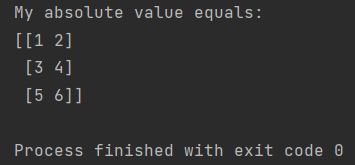This Python guide introduces you to calculating the absolute value using Numpy, along with several practical techniques.

Basic Absolute Value Calculation
To calculate the absolute value of a number, the abs method is your straightforward option.
import numpy as np
my_scalar = -77
my_abs_value = np.abs(my_scalar)
print(f"My absolute value equals: {my_abs_value}")
For example, the absolute value of the scalar value -77 is 77.
You can also calculate the absolute values of arrays in a similar manner:
import numpy as np
my_array = np.array([-1, -2])
my_abs_value = np.abs(my_array)
print(f"My absolute value equals: {my_abs_value}")
For instance, applying np.abs() to a NumPy array containing the elements -1 and -2 yields a new array with the absolute values [1, 2].
Regardless of the array’s size, the calculation remains the same:
import numpy as np
my_array = np.array([[-1, -2], [3, -4], [-5, 6]])
my_abs_value = np.abs(my_array)
print(f"My absolute value equals: \n{my_abs_value}")

Calculating Absolute Differences in Numpy Matrices
You can also compute the absolute difference between Numpy matrices:
import numpy as np
my_first_array = [[-2, -3, 4], [-4, 5, -6]]
my_second_array = [[-1, 2, 7], [-8, 9, -9]]
my_first_array, my_second_array = map(np.array, (my_first_array, my_second_array))
abs_difference = np.abs(my_first_array) - np.abs(my_second_array)
print(f"The absolute difference between arrays equals: \n{abs_difference}")

In this demonstration, we have applied np.abs() separately to two arrays and then computed the element-wise difference of these absolute value arrays. NumPy’s vectorized operations enable a wide range of mathematical computations on arrays and matrices in an analogous manner.
Numpy Functions for Absolute Value
Numpy provides two functions for absolute value calculations: np.abs() and np.absolute(). Both functions are functionally identical, so you can use either one based on your preference. The shorter np.abs() is commonly used for brevity.
